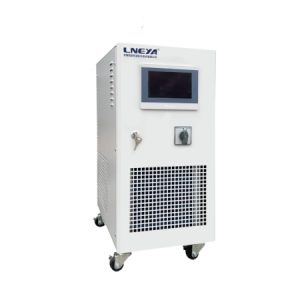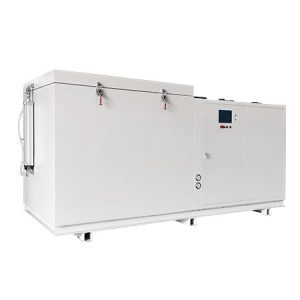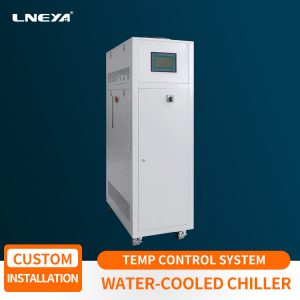주사 전자 현미경 냉각수 순환 시스템
Scanning Electron Microscope (SEM) is a high-resolution microscope widely used in materials science, biology, nanotechnology and other fields. SEM generates a certain amount of heat during operation. In order to ensure the stable operation and image quality of the microscope, an efficient cooling water circulation system is required to control the temperature inside the SEM.
The following are the key components and working principles of the cooling water circulation system of the scanning electron microscope: Key components:
- Circulation pump: responsible for promoting the circulation of cooling water in the system to ensure that the cooling water can flow evenly through various cooling points inside the SEM.
- Cooling water tank: stores cooling water, usually contains filters and chemical additives to maintain the purity of cooling water and prevent corrosion.
- Heat exchanger: transfers the heat in the cooling water to the external cooling medium (usually air or water) through the heat exchanger to achieve the purpose of cooling.
- Temperature controller: monitors the temperature of the cooling water and adjusts the temperature of the cooling water through automatic control systems such as PID controllers to ensure that it is stable within the set temperature range.
- Filter: Filter impurities in cooling water to prevent clogging of the cooling system.
- Pipes and valves: Connect various components to ensure that cooling water can circulate smoothly.
Working principle:
- Cooling water circulation: Cooling water flows out of the cooling water tank and enters the cooling channel or cooling plate inside the SEM through the circulation pump to absorb the heat generated inside the SEM.
- Heat exchange: The cooling water that has absorbed heat then flows into the heat exchanger, where the heat is transferred to the external cooling medium through the heat exchanger to achieve cooling of the cooling water.
- Temperature control: The temperature controller continuously monitors the temperature of the cooling water and adjusts the speed of the circulation pump, the flow rate of the cooling water or the working state of the heat exchanger as needed to keep the temperature of the cooling water stable within the set range.
- Circulation reflux: The cooled cooling water returns to the cooling water tank again to prepare for the next cycle.
- Filtration and maintenance: After a period of use, the cooling water needs to be filtered to remove impurities, and the cooling water and chemical additives need to be replaced regularly to keep the system clean and efficient.
Key requirements:
- Temperature control accuracy: It is usually necessary to control the temperature of the cooling water within the range of ±0.5°C to ±1°C to ensure the stability of the temperature inside the SEM.
- Circulation efficiency: Ensure that the cooling water can circulate efficiently to avoid local overheating. • Safety and protection: The system should have safety measures such as over-temperature protection and pressure protection to ensure the safe operation of the equipment.
- Low noise: The circulation pump and heat exchanger should reduce noise as much as possible to avoid interference with the operation of the SEM.
- Maintenance convenience: The design should be easy to maintain and clean to ensure long-term stable operation.
In summary, the cooling water circulation system of the scanning electron microscope ensures the stability of the temperature inside the SEM by accurately controlling the temperature of the cooling water, thereby improving the imaging quality and stability of the microscope.
관련 권장 사항
-
새로운 에너지 기업을 위한 냉각수 냉각기에는 어떤 테스트가 사용되나요?
958제품 개발, 생산 및 품질 관리 과정에서 새로운 에너지 기업은 냉각수 냉각기를 사용하여 다양한 테스트를 수행합니다. 냉각수 냉각기는 이러한 테스트에서 성능을 보장하기 위해 중요한 역할을 합니다.
세부 정보 보기 -
Refrigeration Unit Water Cooling Chiller
817The chiller water cooling system is an efficient cooling solution that removes heat by circulating cooling water. This system is widely used in industrial, laboratory and commercial environments, especially in applications that require precis...
세부 정보 보기 -
What instruments in biopharmaceutical processes require cooling water systems?
884In biopharmaceutical processes, many critical equipment and instruments require cooling water systems to maintain their normal operation and process temperature control. The following are some common types of equipment that require cooling w...
세부 정보 보기 -
The key points of using cryogenic refrigerator for cooling reaction
1160The cryogenic refrigerator is also called chiller or cryogenic refrigeration circulator. It is an experimental instrument that can achieve low temperature -110 degrees refrigeration. This kind of equipment is often used in single-fluid refrigerati...
세부 정보 보기 -
Heavy Industry Workpiece Cold Assembly Freezer
837In the heavy industry, cold assembly freezers (also called industrial freezers or cryogenic freezers) are used to cool and store large workpieces or materials to meet specific process requirements. This equipment is often used in metal...
세부 정보 보기 -
Ultra-low temperature freezer power supply and electronic control instrument system description
1302Ultra-low temperature freezer needs to be tested after a long time of use. What should be paid attention to when the power supply and electronic control instrument system are inspected? Check the ultra-low temperature freezer power supply and the ...
세부 정보 보기 -
Cause Analysis of Poor Cooling Effect of Water Cooled Chiller
963Water cooled chillers have been more and more widely used in all walks of life around us. Its main function is to provide industrial chilled water for equipment or products. The water temperature range can be adjusted according to users' needs, an...
세부 정보 보기
 LNEYA 산업용 냉각기 제조업체 공급 업체
LNEYA 산업용 냉각기 제조업체 공급 업체














